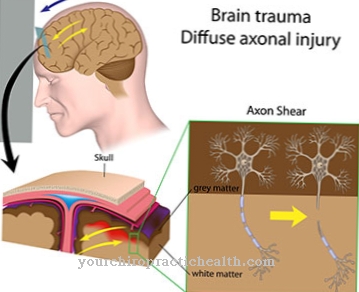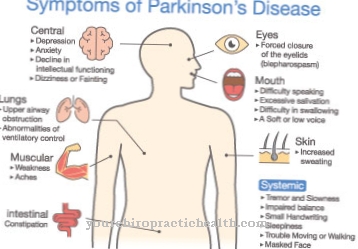The allergic bronchopulmonary aspergillosis describes a reaction to a fungal infection in the respiratory tract. The fungus then triggers chronic reactions that lead to recurrent inflammation of the lungs. The disease mainly occurs in people with chronic lung problems, such as asthma and cystic fibrosis.
What is allergic bronchopulmonary aspergillosis?

Allergic bronchopulmonary aspergillosis is a lung disease caused by mold of the Aspergillus genus. The Aspergillus fumigatus type is one of the most common allergenic molds.
Very often allergic bronchopulmonary aspergillosis occurs as a complication of cystic fibrosis. This affects 10 to 15 percent of patients, preferably in the second decade of life. The allergic bronchopulmonary aspergillosis is divided into different stages:
- Stage I: first manifestation (first appearance of the disease)
- Stage II: remission (symptoms recede temporarily)
- Stage III: exacerbation - renewed worsening of the clinical picture
- Stage IV: severe asthma
- Stage V: Lung tissue shows irreversible fibrotic changes
The allergic bronchopulmonary aspergillosis is divided into five stages, but these are not phases, because the affected person can be in the fifth stage at the first diagnosis. In addition, a reverse development from a higher to a lower level is possible.
causes
Allergic bronchopulmonary aspergillosis affects up to 25 percent of cystic fibrosis patients. People who suffer from asthma also often get it. The triggering allergens are components of mold spores, especially Aspergillus species. The most important sources include flower pots, aquariums, damp areas in the house, hydroponics, organic waste, humidifiers, air conditioning systems and animals with fur and feathers and their surroundings.
Depending on the wind direction, animal stalls, barns with hay and straw, ponds and silos are also a source of danger. Mold spores occur, for example, on the ground, in dust and water, are transported very far by the wind and can be inhaled very easily, which can trigger allergic bronchopulmonary aspergillosis.
Symptoms, ailments & signs
The allergic bronchopulmonary aspergillosis causes various symptoms. Bronchospasm, swelling of the mucous membranes and increased production of mucus in the bronchi occur. Another consequence is a loss of function in the alveoli and in the intercellular tissue of the lungs.
The following additional symptoms can occur: fever, coughing up mucus and brownish discolored sputum, as well as pain in the chest. Shortness of breath and weight loss can also occur. According to the symptoms, the disease is easy to confuse with tuberculosis. In addition, the symptoms are similar to those of the diseases cystic fibrosis and asthma, so that those affected who suffer from them often do not recognize allergic bronchopulmonary aspergillosis.
Diagnosis & course
Because symptoms are very similar to symptoms of cystic fibrosis and asthma, it can be difficult to diagnose allergic bronchopulmonary aspergillosis. Other possible causes such as pneumonia must first be ruled out. The following examinations are available to the doctor: X-ray of the chest, computed tomography, blood test, sputum culture and a skin test.
The earlier allergic bronchopulmonary aspergillosis is recognized and treatment is initiated, the more favorable the course of the disease. Allergic bronchopulmonary aspergillosis can be treated well with medication, but the lungs must be checked regularly as the disease can worsen.
In severe cases, allergic bronchopulmonary aspergillosis can permanently affect the central airways, making them widen, which leads to bronchiectasis. It can also cause severe breathing problems or heart failure. These serious complications are more common in those with advanced cystic fibrosis.
Without treatment for allergic bronchopulmonary aspergillosis, chronic bronchial asthma and fibrosis (scarred areas of the lungs) develop, which are no longer available for gas exchange.
Complications
Allergic bronchopulmonary aspergillosis is an infectious reaction of the respiratory tract due to fungal spores. It is a recurring symptom that predominantly affects young people with chronic lung conditions such as cystic fibrosis or asthma. There are a total of five stages of the symptom: the first manifestation, followed by the temporary regression of the symptoms, further deterioration, asthma flare-up, irreversible lung dysfunction up to the formation of fibrosis.
Various allergens can cause the symptom at any time. These include specifically Aspergillus species and the components of mold spores. These can be found in air conditioning systems, in organic waste, on animals with fur, near silos and in house dust.
If allergic bronchopulmonary aspergillosis is left untreated, serious complications develop, especially for cystic fibrosis patients. In addition to side effects such as weight loss, fever and chest pain, chronic bronchial asthma or bronchospasm can develop. The function of the lungs is increasingly impaired and there is a risk of scarring in the intercellular tissue.
As the disease progresses, acute breathing problems and cardiovascular failure arise. Allergy sufferers and people at risk should use various test options on the basis of a differential diagnosis in good time in order to specifically reduce the fungal infection of the respiratory tract. Cortisone and anti-inflammatory, anti-allergic drugs are given as emergency preparations. Depending on the severity of the case, this can result in secondary complications. In some cases, those affected need lifelong drug therapy with regular lung function checks.
When should you go to the doctor?
In the case of allergic bronchopulmonary aspergillosis, immediate treatment by a doctor is necessary. If the disease is not treated, there is usually no spontaneous improvement and in the worst case the person affected can die from this disease. Since it is characterized by difficulty breathing and shortness of breath, a doctor should be consulted immediately if these symptoms occur.
As a rule, either the general practitioner or an ENT doctor can be visited. In an acute emergency, the patient should call an ambulance or go to the hospital. Furthermore, weight loss is also a common symptom of this disease. Pneumonia and fever continue to occur.
It is not uncommon for chest pain to occur, which should also be examined by a doctor. If there is a stinging in the chest, an emergency doctor must be notified immediately, as this may be a heart problem. The affected person can die of heart failure. Treatment is therefore essential.
Doctors & therapists in your area
Treatment & Therapy
In the initial phase, a longer cortisone treatment is usually necessary. The treatment is partly supported with a fungus agent to reduce the amount of mold exposure in the bronchi. Antiallergic medication can also reduce inflammation.
The doctor may also prescribe an asthma medication to open the airways and make it easier to cough up the mucus. It also helps to remove the fungus from the airways. The primary goal of therapy for allergic bronchopulmonary aspergillosis is to reduce the symptoms when relapses occur and to prevent further relapses by fighting the fungal infection of the respiratory tract.
This is to prevent the disease from worsening. It is also crucial to avoid the allergen immediately as far as possible, as otherwise the fungal attack cannot be stopped. Even if symptoms improve before the recommended dose, the medication should only be discontinued after consulting a doctor. This enables comprehensive treatment and reduces the risk of relapse.
Outlook & forecast
As a rule, this disease causes various respiratory problems. Those affected suffer from recurring inflammations and infections, which can also lead to asthma. The quality of life of the patient is significantly restricted and reduced by this disease. Likewise, certain activities in everyday life can no longer be carried out easily and the resilience of the person concerned drops significantly. Furthermore, there is often a swelling of the mucous membranes. Those affected also suffer from fever and gasping for breath. Weight loss can also occur.
The patients often suffer from pneumonia, which in the worst case can be fatal. The insufficient supply of oxygen can also damage the internal organs, which can also affect the heart and brain. If the heart is damaged, it can also lead to cardiac death. Damage to the brain can cause irreversible consequential damage.
As a rule, the disease is limited with the help of medication. However, not all complaints can be treated in every case. Existing infections are treated with the help of antibiotics. Successful treatment of this disease will not reduce life expectancy.
prevention
Allergic bronchopulmonary aspergillosis is difficult to avoid because the fungus that causes it occurs in the normal environment. But it is possible to counteract recurring attacks if the prescribed medication is taken as directed by a doctor. It is also important to avoid the allergen once the diagnosis is made.
This means staying away from possible sources of infection in the environment. This is also the reason that visitors are not allowed to bring potted plants to the hospital with potting soil, as this is one of the various sources of danger. At home, it is advisable to avoid contact with soil, compost and organic waste as much as possible.
The allergic bronchopulmonary aspergillosis mostly affects people who have already suffered from bronchial asthma. Cystic fibrosis can also promote the development of a hypersensitivity reaction to Aspergillus spores. This complication makes treatment and follow-up of the underlying disease difficult.
Aftercare
The colonization of the respiratory tract of previously contaminated patients with Aspergillus spores can have serious consequences if left untreated. Follow-up care is therefore urgently required after acute treatment. Asthma and fibrosis patients need regular follow-up checks anyway. The medication doses may have to be adjusted. With regard to allergic bronchopulmonary aspergillosis, the stage at which it is located is decisive.
For asthma patients who are treated with long-term corticosteroid therapies, the question of the side effects of this therapy arises for follow-up care. As a result, the corticosteroids can lead to cataracts, hyperglycaemia or osteoporosis. Therefore, part of the follow-up care may be to prevent these consequences - for example, by administering prophylactic drugs to mineralize bones or to prevent certain types of pneumonia. The extent to which the immunological function can be strengthened varies from person to person.
What is precarious about allergic bronchopulmonary aspergillosis is that the existing asthma disease can only be treated to a limited extent. This leads to recurrent lung infiltrates. Therapy and follow-up measures must be individually tailored to the patient. There is currently no standard treatment.
You can do that yourself
In order to help themselves, the person affected should obtain comprehensive information about where the pathogen is at home and how it is spread. It is helpful if he develops an appropriate sensitivity for his environment, where the fungus is often located, in order to avoid danger zones in good time. In some cases, lifestyle changes or a move are necessary to alleviate the symptoms over the long term.
In addition, it is necessary to strengthen and stabilize your own immune system. Only in this way can it produce sufficient defenses to deal with the pathogens. A healthy lifestyle is required to optimize the functioning of the immune system. This includes a balanced diet, sufficient exercise and the avoidance of harmful substances.
The pollutants include nicotine, alcohol or drugs. Toxins such as paints, chemical cleaning agents or building materials should also not be inhaled. Maintaining the ideal weight is also helpful in order not to put additional strain on the airways. Heavy physical work should be avoided and sporting activities should be tailored to the possibilities available.
In addition, sufficient periods of regeneration help to promote health. If breathing becomes difficult, take breaks immediately and take prescribed medication. If fears arise due to the breathing problems, the use of therapy can help.


.jpg)

.jpg)






















